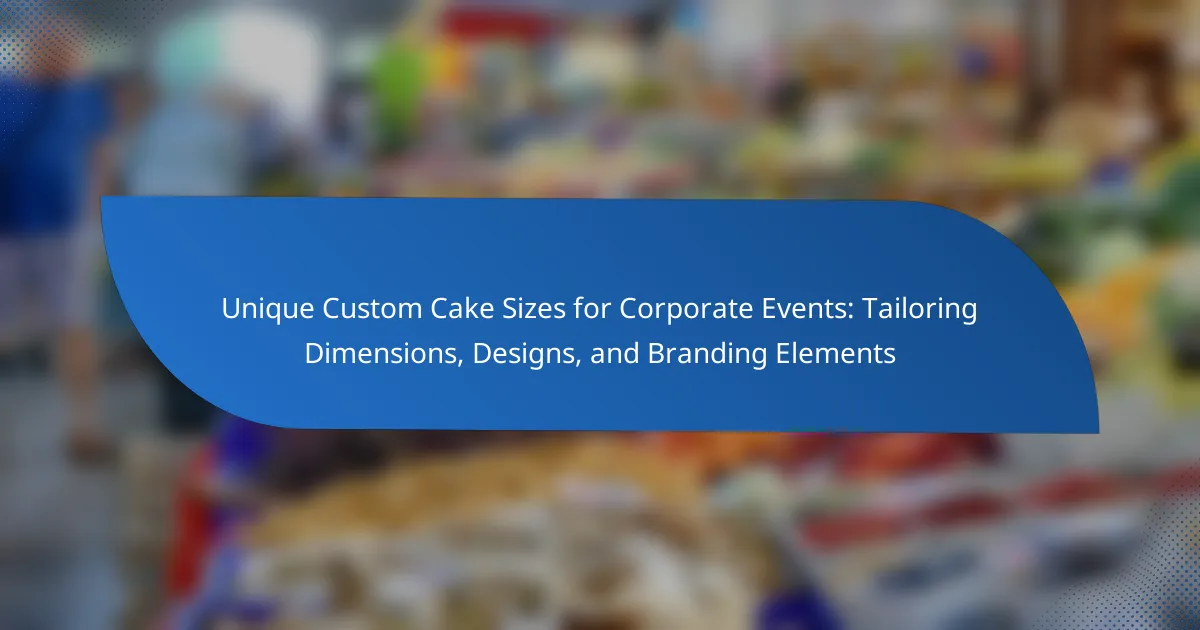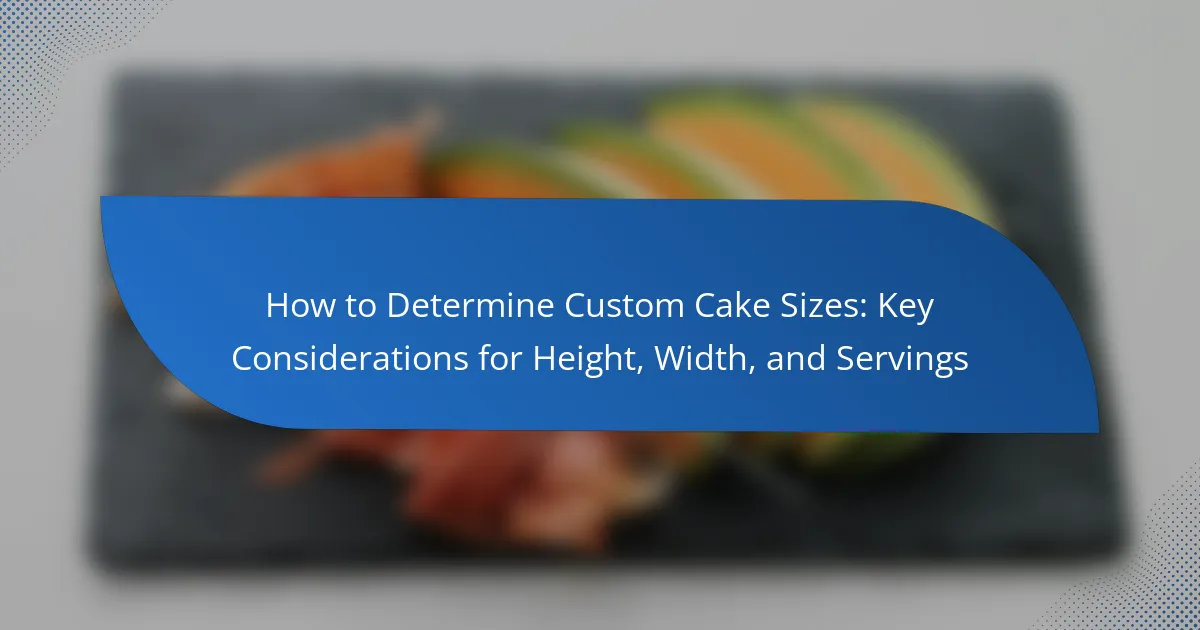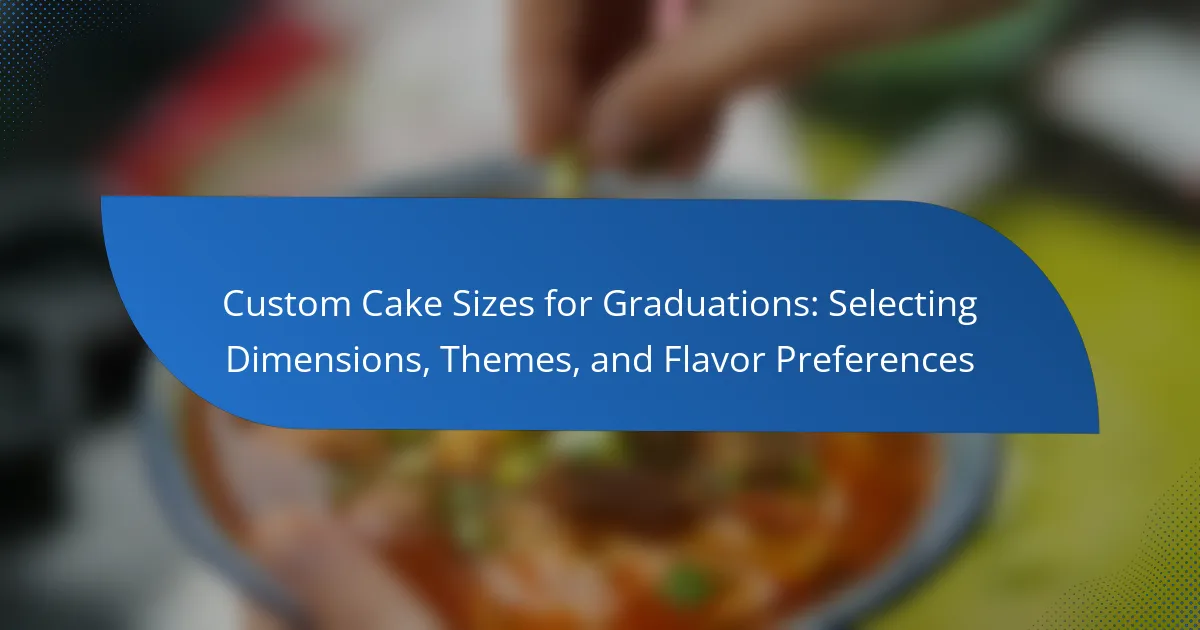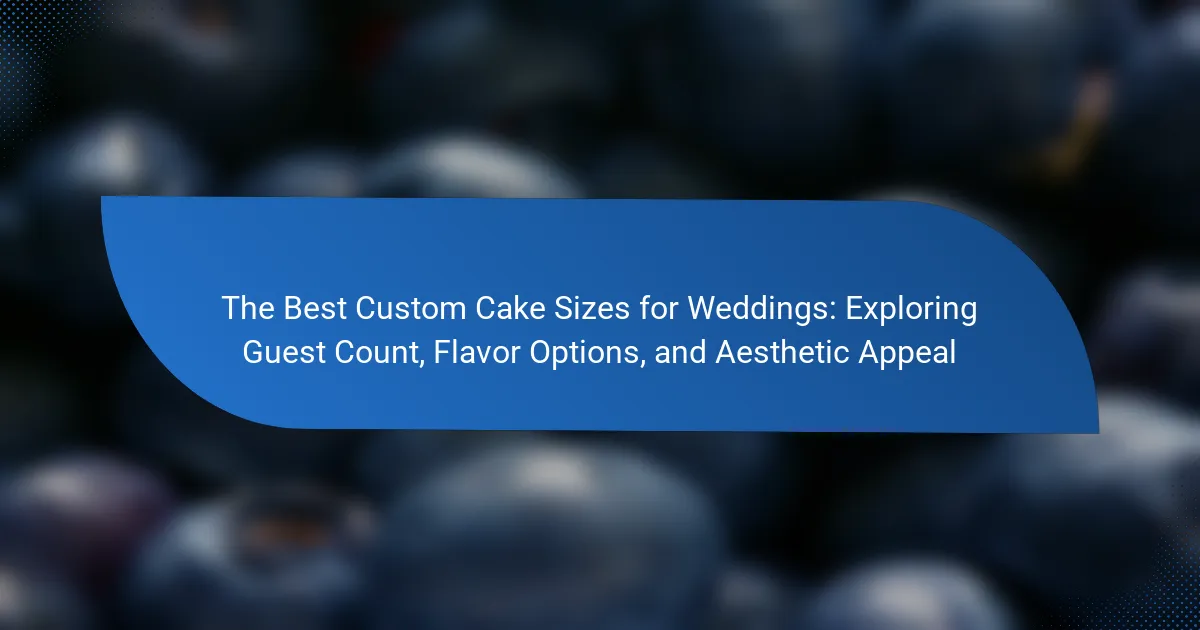Custom cakes for seasonal celebrations are designed to cater to specific occasions and guest counts, with common sizes including 6-inch, 8-inch, and 10-inch round cakes, as well as various sheet cakes. Bakeries often provide tiered options, allowing for creative designs that enhance visual appeal. Flavor trends vary by season, featuring options like pumpkin spice in fall, peppermint in winter, fresh fruits in spring, and tropical flavors in summer. When selecting a custom cake, it is essential to consider the event’s theme, guest count, and preferred flavors, while also addressing dietary restrictions. Consulting with a professional baker can help ensure the cake aligns with the celebration’s vision and requirements.
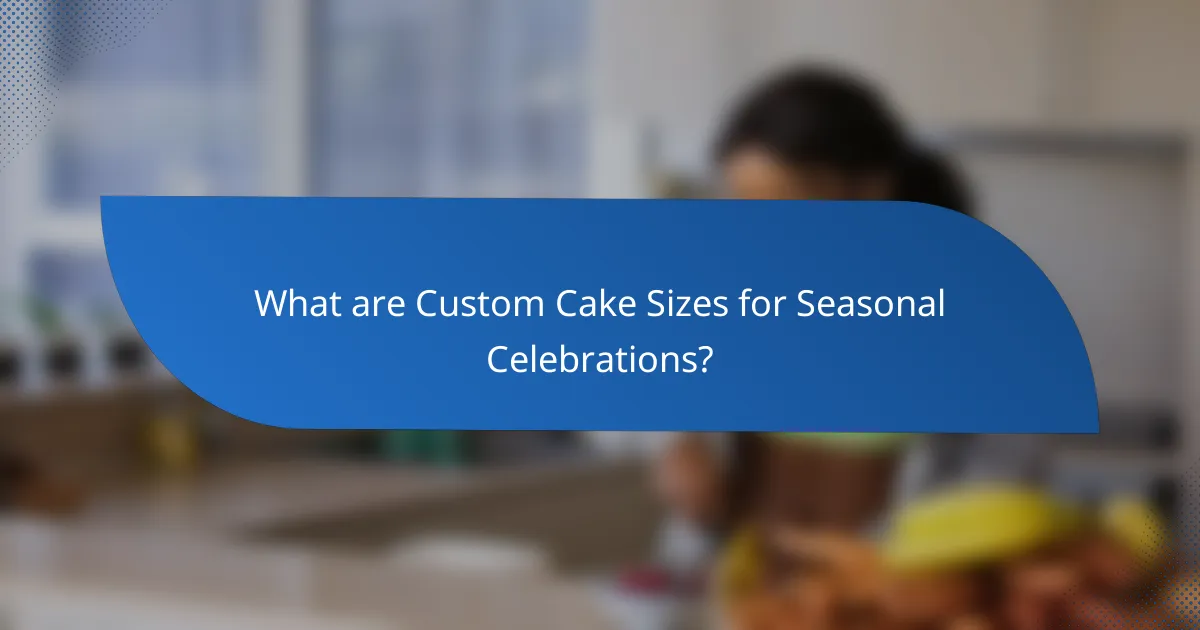
What are Custom Cake Sizes for Seasonal Celebrations?
Custom cake sizes for seasonal celebrations vary based on the number of servings required and the occasion. Common sizes include 6-inch, 8-inch, and 10-inch round cakes. Larger gatherings may opt for sheet cakes, such as quarter, half, or full sheets. Custom sizes can also be created to fit specific themes or designs, enhancing the celebration’s visual appeal. Many bakeries offer tiered cakes, which combine different sizes for a dramatic effect. For instance, a three-tier cake may consist of a 6-inch top tier, an 8-inch middle tier, and a 10-inch bottom tier. These options allow for flexibility in serving sizes and presentation. Customization can also include unique shapes, such as heart or star, tailored to the event’s theme.
How do custom cake sizes enhance seasonal celebrations?
Custom cake sizes enhance seasonal celebrations by allowing for personalization and adaptability. Custom sizes can cater to specific guest counts, ensuring everyone is served. They can also align with the theme of the celebration, such as a large cake for a wedding or smaller cakes for intimate gatherings. This flexibility fosters creativity in design and flavor combinations. Seasonal ingredients can be highlighted in custom cakes, enhancing the overall experience. Custom cakes can also serve as a focal point, elevating the aesthetic of the celebration. By accommodating diverse dietary needs, custom sizes ensure inclusivity for all guests. Ultimately, custom cake sizes contribute to memorable and tailored seasonal celebrations.
What factors influence the choice of cake size for different occasions?
The choice of cake size for different occasions is influenced by the number of guests. Larger gatherings require bigger cakes to ensure everyone is served. The type of event also plays a role. Weddings typically feature larger cakes compared to birthday parties. Budget constraints can limit size options, as larger cakes are more expensive. Additionally, the theme of the occasion may dictate cake size. A grand celebration may warrant a multi-tiered cake, while a casual gathering may only need a small cake. Finally, personal preferences and dietary considerations can impact the decision. For example, a health-conscious group might prefer smaller portions.
How do custom sizes cater to varying guest counts?
Custom sizes accommodate varying guest counts by providing tailored portions for specific events. This ensures that each guest receives an appropriate serving without excess waste. For instance, a cake designed for 20 guests will have different dimensions compared to one meant for 50 guests. This customization allows for better planning and budget management. Research shows that accurately sized cakes can reduce food waste by up to 30%. Additionally, custom sizes enable hosts to align their cake choices with the overall theme and aesthetics of the celebration. This approach enhances guest satisfaction by ensuring everyone is served adequately.
What dimensions are commonly used for custom cakes?
Common dimensions for custom cakes include 6-inch, 8-inch, 10-inch, and 12-inch round cakes. These sizes are standard for serving various numbers of guests. A 6-inch cake typically serves 6-8 people. An 8-inch cake serves about 10-12 guests. A 10-inch cake can accommodate 14-20 servings. A 12-inch cake often serves 24-30 guests. Custom cakes can also be made in square shapes, with common sizes being 8×8 inches and 10×10 inches. Each size can be adjusted based on specific event needs.
What are the standard sizes for round cakes?
The standard sizes for round cakes are typically 6, 8, 9, 10, 12, and 14 inches in diameter. These measurements are commonly used in baking and cake decorating. Each size serves a different number of people. For example, a 6-inch cake usually serves about 6 to 8 people. An 8-inch cake can serve approximately 10 to 12 people. A 9-inch cake generally serves about 12 to 14 people. A 10-inch cake is suitable for around 15 to 20 servings. A 12-inch cake typically serves 25 to 30 people. Finally, a 14-inch cake can serve about 40 to 50 people. These sizes are widely recognized in the baking industry and are used for various occasions.
How do square and tiered cakes differ in dimensions?
Square cakes are typically uniform in height and width, while tiered cakes consist of multiple layers with varying dimensions. Square cakes often have a single layer, measuring, for example, 8 inches by 8 inches and 4 inches high. In contrast, tiered cakes can have different sizes for each layer, such as a 10-inch base tier and an 8-inch middle tier, with heights that can range from 4 to 6 inches per layer. This results in tiered cakes being taller and more visually striking than square cakes. The dimensional differences allow for creative designs and presentations in tiered cakes, which are often used for special occasions.
Why are themes important in custom cake design?
Themes are important in custom cake design because they provide a cohesive visual and conceptual framework. A well-defined theme enhances the overall aesthetic appeal of the cake. It helps to reflect the occasion, whether it’s a birthday, wedding, or holiday celebration. Themes guide the choice of colors, decorations, and flavors, ensuring they align with the event’s purpose. For instance, a winter theme may incorporate snowflakes and cool colors, while a tropical theme might feature vibrant colors and fruit designs. This alignment creates a memorable experience for guests. Additionally, themed cakes can serve as focal points at events, making them more engaging and enjoyable.
What seasonal themes are popular for custom cakes?
Popular seasonal themes for custom cakes include holiday motifs, seasonal fruits, and nature-inspired designs. For example, winter themes often feature snowflakes and holiday colors. Spring cakes commonly showcase floral decorations and pastel colors. Summer themes may include beach motifs and vibrant fruits. Autumn cakes often highlight leaves, pumpkins, and warm colors. Each theme reflects the characteristics of the season and caters to celebratory events. Custom cakes designed around these themes enhance the festive atmosphere of seasonal celebrations.
How does the theme affect the cake size and shape?
The theme significantly influences the cake size and shape. Specific themes often dictate design elements, which in turn affect dimensions. For example, a wedding theme may require a multi-tiered cake for grandeur. Conversely, a children’s party theme might favor smaller, whimsical shapes like animals or cartoon characters. The visual representation of the theme guides bakers in choosing appropriate sizes. Additionally, cake themes can dictate the need for unique shapes, such as a heart for anniversaries or a star for celebrations. These design choices ensure the cake aligns with the overall event aesthetics. Therefore, the theme directly shapes both the size and form of the cake to enhance the celebration’s visual impact.
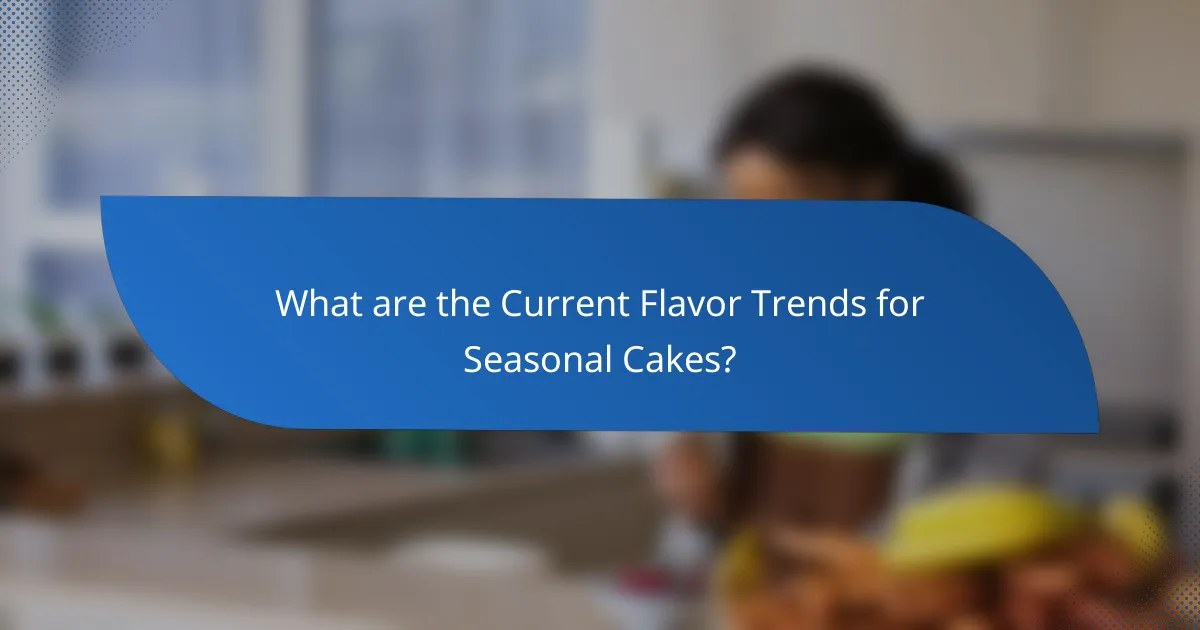
What are the Current Flavor Trends for Seasonal Cakes?
Current flavor trends for seasonal cakes include a variety of innovative and nostalgic options. Popular flavors for fall include pumpkin spice and apple cinnamon, reflecting traditional seasonal tastes. Winter cakes often feature flavors like peppermint and gingerbread, appealing to holiday festivities. Spring trends highlight fresh fruit flavors such as lemon and strawberry, celebrating the season’s bounty. Summer cakes frequently incorporate tropical flavors like coconut and mango, offering refreshing options. These trends show a blend of classic and contemporary flavors, catering to diverse palates. Seasonal cake preferences are influenced by cultural traditions and modern culinary creativity.
How do flavor trends influence custom cake choices?
Flavor trends significantly influence custom cake choices by guiding consumer preferences and demand. Popular flavors often reflect current culinary trends, such as the rise of unique and exotic ingredients. For example, flavors like matcha, salted caramel, and lavender have gained traction in recent years. This shift encourages bakers to innovate and offer diverse options to meet customer expectations. Additionally, social media platforms showcase trending flavors, leading to increased visibility and popularity. As a result, customers may choose cakes based on these trends to align with contemporary tastes and celebrations.
What are the most popular flavors for seasonal celebrations?
The most popular flavors for seasonal celebrations include vanilla, chocolate, red velvet, and carrot cake. Vanilla is often favored for its versatility and ability to pair with various fillings and frostings. Chocolate is a classic choice that appeals to many due to its rich taste. Red velvet, with its distinct color and cream cheese frosting, is particularly popular during holidays like Valentine’s Day and Christmas. Carrot cake, often associated with Easter, offers a unique flavor profile with spices and nuts. These flavors are frequently chosen for their wide appeal and compatibility with festive themes.
How can flavors be paired with cake sizes and themes?
Flavors can be paired with cake sizes and themes by considering the occasion and the preferences of the guests. For smaller cakes, such as individual servings, lighter flavors like lemon or vanilla work well. These flavors complement intimate settings like weddings or birthdays. Larger cakes, such as tiered designs, can feature richer flavors like chocolate or red velvet. These flavors suit grander themes like anniversaries or corporate events.
The theme can also influence flavor choices. For a rustic theme, flavors like spice cake or carrot cake match well. For a modern theme, trendy flavors like salted caramel or matcha can enhance the design. Seasonal ingredients can also guide flavor selection. In fall, flavors like pumpkin spice resonate with autumn celebrations. In summer, fruity flavors like strawberry or mango align with warm-weather themes.
Overall, matching flavors to cake sizes and themes enhances the overall experience and satisfaction of the event.
What role do dietary preferences play in custom cake flavor selection?
Dietary preferences significantly influence custom cake flavor selection. These preferences include restrictions such as vegan, gluten-free, or nut-free diets. Consumers with dietary restrictions seek flavors that align with their needs. For example, vegan cakes often use plant-based ingredients like almond or coconut milk. Gluten-free options may feature alternative flours like almond or rice flour. Additionally, flavor choices may be limited by these dietary needs. This ensures that all guests can enjoy the cake without health concerns. A survey by the Specialty Food Association found that 57% of consumers consider dietary restrictions when choosing desserts. Thus, understanding dietary preferences is crucial for creating inclusive and appealing custom cakes.
How can bakers accommodate gluten-free or vegan options?
Bakers can accommodate gluten-free or vegan options by using alternative ingredients. For gluten-free baking, they can substitute traditional flour with almond flour, coconut flour, or gluten-free blends. These alternatives help maintain texture and flavor in baked goods.
For vegan options, bakers can replace eggs with flaxseed meal or applesauce. Plant-based milk such as almond or oat milk can substitute dairy milk. Additionally, using coconut oil or vegan butter can replace traditional butter in recipes.
Many consumers prefer these options, as the gluten-free market is projected to grow significantly. Vegan diets are also on the rise, with a 600% increase in the number of people identifying as vegan in the last three years. This indicates a strong demand for gluten-free and vegan baked goods.
What unique flavor combinations are trending among custom cakes?
Unique flavor combinations trending among custom cakes include lavender and lemon, chocolate and chili, and matcha with white chocolate. Lavender and lemon create a refreshing and aromatic experience. Chocolate and chili offer a spicy twist to classic flavors. Matcha and white chocolate provide a unique blend of earthy and sweet notes. These combinations reflect current consumer preferences for bold and innovative tastes in desserts.
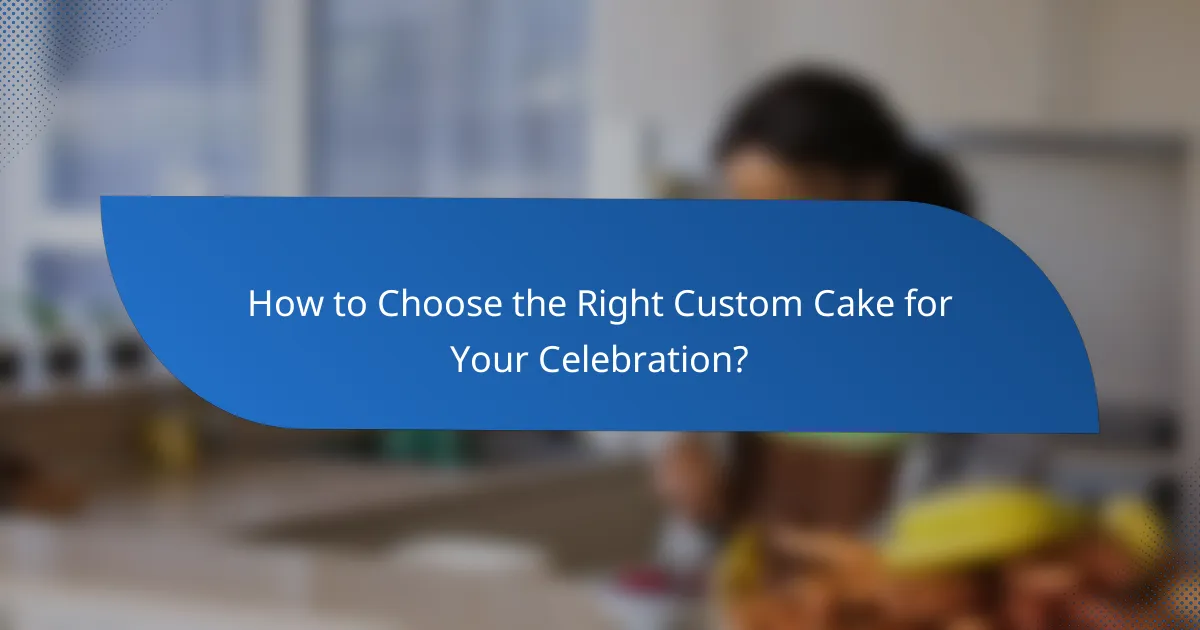
How to Choose the Right Custom Cake for Your Celebration?
To choose the right custom cake for your celebration, first consider the event’s theme. This will guide the cake’s design, colors, and decorations. Next, determine the number of guests to ensure the cake is appropriately sized. A general rule is to allocate one slice per person.
Select flavors that appeal to the majority of your guests. Popular options include vanilla, chocolate, and red velvet. Additionally, consider dietary restrictions, such as gluten-free or vegan options.
Consult with a professional baker to discuss your ideas and preferences. They can provide valuable insights on design feasibility and flavor combinations. Finally, review portfolios of previous work to ensure the baker’s style aligns with your vision.
What considerations should be made when selecting a cake size?
When selecting a cake size, consider the number of guests. The cake should serve the expected attendees at the event. A standard serving size is typically one slice per person. Additionally, account for the occasion’s formality. Formal events may require larger cakes for a more impressive presentation.
Next, consider the cake’s design and tiers. Elaborate designs may need more height and space. The type of cake matters too; dense cakes may require smaller portions than lighter cakes. Lastly, factor in dietary restrictions. Some guests may need gluten-free or vegan options, influencing the overall size needed.
How do guest preferences impact the final cake decision?
Guest preferences significantly influence the final cake decision. The flavors, designs, and sizes chosen often reflect what guests enjoy. For instance, surveys indicate that 70% of guests prefer chocolate or vanilla flavors. Additionally, dietary restrictions, such as allergies or vegan choices, must be considered. The theme of the celebration also plays a role in cake aesthetics. A wedding cake, for example, may need to align with the overall wedding theme. Ultimately, understanding guest preferences ensures higher satisfaction and enjoyment during the event.
What tips can help ensure a successful custom cake order?
To ensure a successful custom cake order, communicate your requirements clearly. Provide specific details about the design, size, and flavor. Share any inspiration images to illustrate your vision. Confirm the order well in advance to secure availability. Discuss dietary restrictions or allergies with the baker. Request a written confirmation of your order details. Arrange for a pickup or delivery time that suits your schedule. Lastly, verify the final price and payment options before finalizing the order.
How should one communicate their vision to a baker?
To communicate a vision to a baker, be clear and specific about your ideas. Start by describing the desired cake size, shape, and theme. Use visual aids like pictures or sketches to illustrate your vision. Discuss flavor preferences and any dietary restrictions. Provide details about the occasion, such as the date and number of guests. This information helps the baker understand your expectations. Clear communication ensures the final product aligns with your vision.
What are common pitfalls to avoid when ordering a custom cake?
Common pitfalls to avoid when ordering a custom cake include not providing clear specifications. Customers should communicate their desired flavors, sizes, and themes effectively. Failing to plan ahead can lead to last-minute issues. Bakers often require advance notice for custom orders. Not considering dietary restrictions can limit options for guests. Customers should inquire about gluten-free or vegan options if needed. Overlooking the importance of a tasting can result in dissatisfaction. Tasting allows customers to ensure the cake meets their expectations. Additionally, ignoring the budget can lead to unexpected costs. Customers should discuss pricing clearly with the baker before finalizing the order.
The main entity of this article is custom cake sizes tailored for seasonal celebrations. It explores how these sizes vary based on guest counts and occasions, including standard dimensions for round and square cakes, as well as tiered options. The article also discusses the importance of themes in cake design, popular seasonal flavors, and how dietary preferences influence cake selection. Additionally, it provides practical tips for choosing the right custom cake, ensuring a successful order while considering guest preferences and dietary needs.
